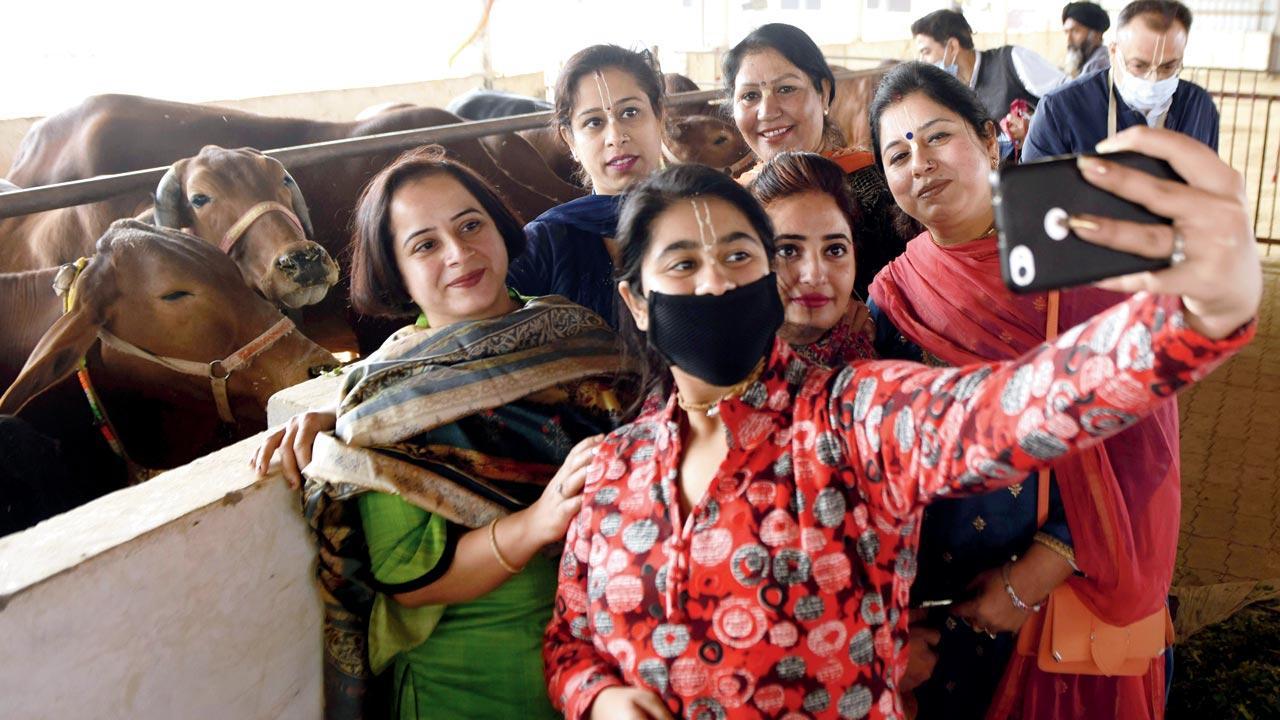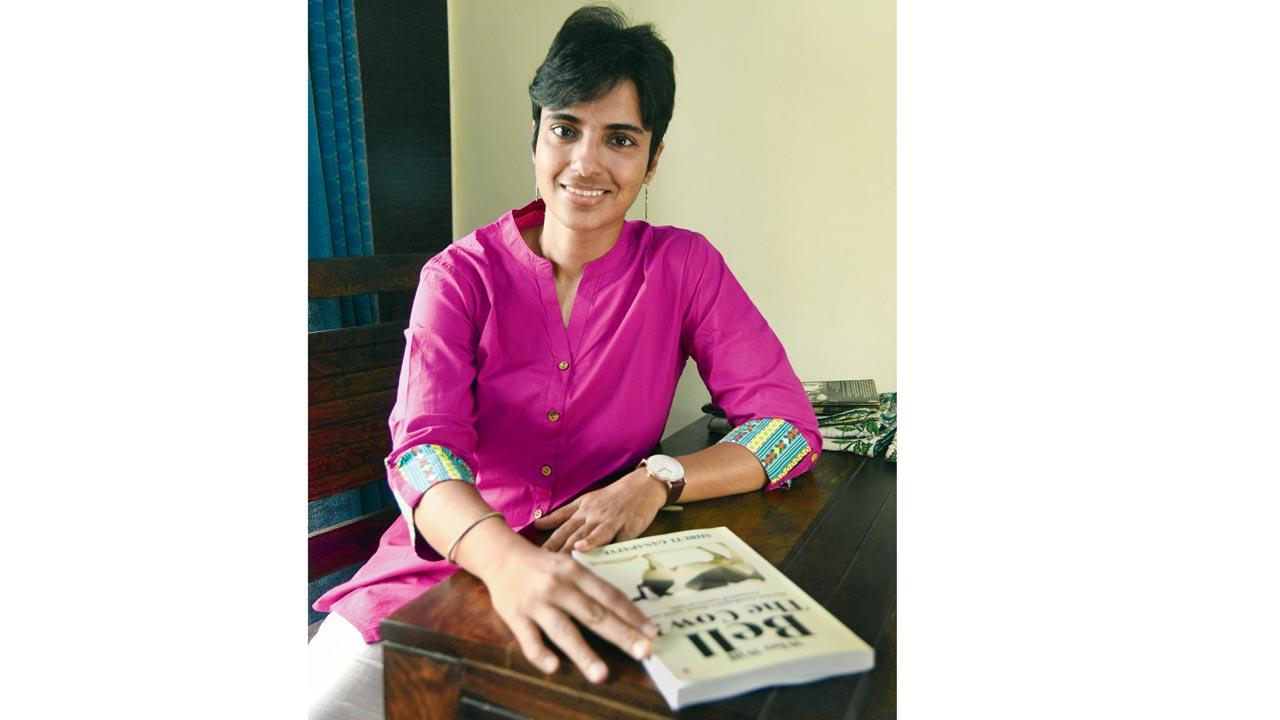A new book uses hard-core data to explore how India’s cow politics could become the reason for the possible extinction of the species

Visitors take a selfie at Sri Gokul Gaushala on the outskirts of Amritsar in a file photo from November 2020. Pic/Getty Images
Mumbai-based independent journalist Shruti Ganapatye is curious about narratives, especially those that involve the sacred cow. A chain of events piqued her interest in the subject—the beef ban and subsequent closure of abattoirs and unauthorised meat shops in BJP-ruled states, including Maharashtra. This had led to a spurt in cow vigilante violence and the rise of the gau rakshak. “Our generation has seen riots in the name of religion, but lynching because of our food choices, was new even to me,” she tells mid-day. In 2019, Ganapatye set out to research the cultural, religious and political history of the beef ban in India, and how it was impacting the economics of a thinking nation. Her just released self-published book, Who Will Bell The Cow? (Notion Press), attempts to peel off the complex layers of cow worship and cow politics, examining why the two must be seen as independent of each other.
ADVERTISEMENT
Edited excerpts from the interview
In the book, you mention that the cow protection movement could eventually lead to the extinction of the species.
Traditionally, cattle are domesticated, farm animals used for agricultural purposes, and are reared for milk and meat. With the ban on cow slaughter in the country, and with agriculture now mostly becoming mechanised, what we are seeing is that farmers are not choosing to raise cows. During my research, I came across a village called Daurala in Western Uttar Pradesh, which has a population of 19,000 people. Here, farmers have stopped buying cows and bulls. There was a time, when there were 200-300 bull pairs in the village. Now, you will hardly find two or three pairs. They now prefer buffalo for milk instead.
Also, look at the census figures. If the logic behind cow slaughter is that we are saving cows, the cow population should have increased manifold. But if you compare the 1951 census with that of 2019, the overall cattle [cows and bulls] population has increased by just 23 per cent, while the buffalo population went up by 153.8 per cent. I also compared the census figures of 2012, when the cow protection movement intensified, with that of 2019 figures, and found that states like Gujarat and Uttar Pradesh, where this movement was on in full swing, in fact saw a reduction in cattle. The narrative doesn’t match with the ground reality. If this cattle is not part of our consumption cycle or not being used in farming, where are they disappearing? Either we are killing them silently or killing them early. And because we no longer have any use of them, we might just be pushing them towards extinction.
 Journalist Shruti Ganapatye filed 90 RTIs across 11 states to source data related to the cow protection movement. Pic/Pradeep Dhivar
Journalist Shruti Ganapatye filed 90 RTIs across 11 states to source data related to the cow protection movement. Pic/Pradeep Dhivar
As part of your research, you visited gaushalas in north India. What did you witness?
There are two kinds of gaushalas—one supported by the government, and others that are run by communities. The government-run gaushalas were in bad shape because there was no monitoring. A subsidy of R20 is provided per day per animal, whereas the requirement is R120-R150 per day for each animal for fodder, medicine, etc. In the absence of monitoring, we don’t know what happens to these animals once they are housed there, as access is restricted and there is no audit from the government’s side. The community-run gaushalas were in far better shape, and the cattle were given sufficient food, shelter and were also well
looked after.
Also, while many state governments have announced schemes for gaushalas and allocated funds for them, there is no way of telling how these funds have been utilised.
You’ve also highlighted the adverse effects of the cow protection movement on the rural economy.
The farmers are the hardest hit, of course. See, the farming economy used to function very simply—you rear a cow for a particular number of years for milk, or use the bull for agricultural purpose, and then once the animal gets old, you sell it to a slaughter house. The cash they earned from selling the cow when old also sustained them [later on]. Now, farmers are forced to keep the animal, because of the fear of gau rakshaks. Some farmers abandon their old cattle, who then go and destroy other farmlands. The rural economy cycle has
been disturbed.
The NCRB, you say in the book, has no data on cow lynching or crimes related to cattle. How did you find leads on cow-related crimes, and what did the findings indicate?
Unfortunately, we don’t have any data on cow lynching compiled by the government, so I sourced data from social organisations that had put together numbers based on what was reported by the public. Over and above this, I filed 90 RTIs across 11 states, asking them three sets of questions—one to the home department about the crimes related to cows, second to the forensics lab to check if they were able to verify whether the meat involved was beef, and finally, to the animal husbandry department asking them about the cattle-related schemes that were launched and if any auditing was done.
Jharkhand was the only state that sent across all the information I had sought; this gave me a sense of the pattern of violence post 2014. UP didn’t share anything, saying that it wasn’t in the interest of the public. Maharashtra did not have data on the total number of crime cases, but the forensics department’s data indicated that the smuggling of beef has increased. My question is this: if we don’t have proper data, on what grounds are we building the cow protection narrative?
Do you see an end to cow politics in India?
Sadly not. Our minds have been trained; there is a philosophy, literature and infrastructure that is ready. There are also people who are ready to volunteer for the movement. Whenever there is a political requirement, the issue will be raised.
 Subscribe today by clicking the link and stay updated with the latest news!" Click here!
Subscribe today by clicking the link and stay updated with the latest news!" Click here!







